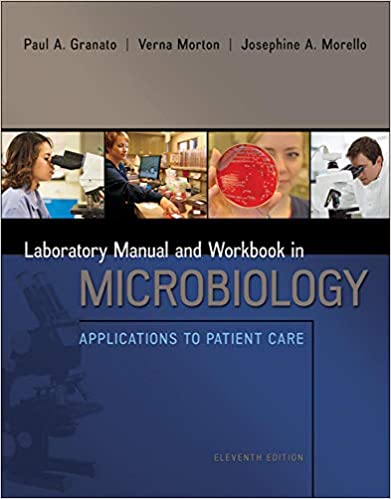
Lab Manual and Workbook in Microbiology 11th Edition by Josephine Morello ,Paul Granato,Verna Morton
Edition 11ISBN: 978-0073402390
Lab Manual and Workbook in Microbiology 11th Edition by Josephine Morello ,Paul Granato,Verna Morton
Edition 11ISBN: 978-0073402390 Exercise 6
A School-Associated Pertussis Outbreak
A 13-year-old eighth grader attended school while experiencing a prolonged cough illness. Bordetella pertussis was isolated in culture from the child. Another student in the same classroom had a clinical illness consistent with pertussis 2 weeks earlier, and subsequently, five additional people (two students in the same classroom, two eighth-grade teachers, and one parent of an ill student) developed the coughing illness. In patients with one or more days of illness, the diagnosis was made by culturing the organism from a nasopharyngeal swab. In patients with more than 14 days of illness, the diagnosis was made by either a positive PCR test for B. pertussis DNA from a nasopharyngeal specimen or by finding a link to a person with a laboratory-confirmed case. Antimicrobial therapy was given to students and staff members with coughing, and they were excluded from school through the fifth day of treatment.
Other cases began appearing throughout six communities in the county. As a result, the pertussis vaccination schedule for infants was accelerated. A total of 483 pertussis cases were reported throughout the outbreak, which lasted 6 months. Genetic testing revealed four DNA profiles of B. pertussis, most of which matched the profile of patients attending the middle school. No patients were hospitalized or died during this outbreak. Early recognition, treatment, and chemoprophylaxis were important in preventing pertussis transmission to others.
What is the recommended age range for receiving the pertussis vaccine?
A 13-year-old eighth grader attended school while experiencing a prolonged cough illness. Bordetella pertussis was isolated in culture from the child. Another student in the same classroom had a clinical illness consistent with pertussis 2 weeks earlier, and subsequently, five additional people (two students in the same classroom, two eighth-grade teachers, and one parent of an ill student) developed the coughing illness. In patients with one or more days of illness, the diagnosis was made by culturing the organism from a nasopharyngeal swab. In patients with more than 14 days of illness, the diagnosis was made by either a positive PCR test for B. pertussis DNA from a nasopharyngeal specimen or by finding a link to a person with a laboratory-confirmed case. Antimicrobial therapy was given to students and staff members with coughing, and they were excluded from school through the fifth day of treatment.
Other cases began appearing throughout six communities in the county. As a result, the pertussis vaccination schedule for infants was accelerated. A total of 483 pertussis cases were reported throughout the outbreak, which lasted 6 months. Genetic testing revealed four DNA profiles of B. pertussis, most of which matched the profile of patients attending the middle school. No patients were hospitalized or died during this outbreak. Early recognition, treatment, and chemoprophylaxis were important in preventing pertussis transmission to others.
What is the recommended age range for receiving the pertussis vaccine?
Explanation
Pertussis or whooping cough is caused by...
Lab Manual and Workbook in Microbiology 11th Edition by Josephine Morello ,Paul Granato,Verna Morton
Why don’t you like this exercise?
Other Minimum 8 character and maximum 255 character
Character 255


